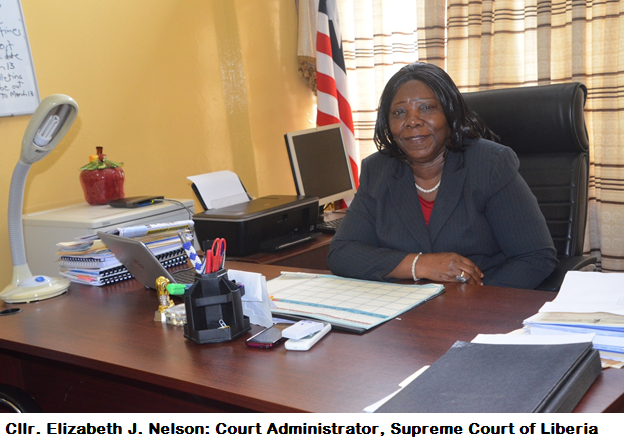OFFICE OF THE COURT ADMINISTRATOR
PROFILE
 Consistent with the Vision and Mission of the Judiciary; in recognition of the vital role of the Judiciary in the delivery of justice to the people; and due to the important nature of the judicial services offered through the Liberian court system; the Office of the Court Administrator is created as the administrative arm of the entire court system, with the primary objective “to organize and manage non-judicial matters” under the direction of the Chief Justice of the Supreme Court.
Consistent with the Vision and Mission of the Judiciary; in recognition of the vital role of the Judiciary in the delivery of justice to the people; and due to the important nature of the judicial services offered through the Liberian court system; the Office of the Court Administrator is created as the administrative arm of the entire court system, with the primary objective “to organize and manage non-judicial matters” under the direction of the Chief Justice of the Supreme Court.
The Court Administrator (must be a Counsellor of the Supreme Court Bar) is currently selected by a process that includes a nomination by the Chief Justice of the Supreme Court Justice, endorsed by the majority of the Associate Justices; and the nominee forwarded to the President for Appointment.
In pursuit of the independence of the Judiciary, it is recommended that the new Judiciary Law be amended to provide that the Court Administrator be appointed by the Chief Justice of the Supreme Court; with the advice and concurrence of the Associate Justices. And shall be removed for cause.
Duties and Responsibilities of the Court Administrator:
Duties and Responsibilities of the Court Administrator shall include, but not limited to the following:
- The collection of judicial data and preparation of court statistics;
- Supervision of all judiciary personnel throughout the country, except judges who shall report to the Chief Justice or the Courts of record which function according to rules governing Court administration, as promulgated by the Supreme Court, and basically to assist the Chief Justice, in performance of all duties which his/her administrative responsibilities impose upon him/her.
- He/she shall prepare and submit to the Chief Justice, an annual report of the administrative operations of the Judicial Branch; and this report shall be submitted on or before 30th September of each year. A statistic of the trial and disposition of cases in all of the courts or the country shall be kept up to date in his/her office, and he/she shall make a monthly report thereon to the Chief Justice, for effective and efficient management of the courts.
In addition to the above mentioned, the Court Administrator’s Office has overall responsibility for the delivery of continuous and efficient court services, and provides technical assistance and administrative support to the various departments of the Court, including other Court businesses such as personnel, fiscal operations, budget, information systems, public relations, and liaison functions with various groups and agencies; the Court Administrator:
- Manages the daily operations of the courts. The duties include acting as a court liaison, managing the court’s budget and directing court employees;
- Plans and oversees a courthouse’s administrative operations, facilities, budget and case management procedures; and
- And also acts as a liaison between the Court and public or private organizations, as well as government.
In the process of enhancing overall administrative effectiveness, the Court Administrator on a day-to-day basis is involved in the following functions:
- Human Resource Management:
The recruitment, selection, training, developing and counseling of court employees; establishing ethical standards and standard operational procedures; administering wage, salary and performance appraisal and reward systems; and facilitating personnel matters for judicial staff.
- Fiscal Administration:
Preparing court budgets; administering accounting, purchasing, payroll, and financial control functions; and guiding the budget through the government review processes (Finance Ministry & Legislative oversight Bodies).
- Case-flow Management:
Evaluating pending caseloads, developing and implementing systems (both automated and procedural) that support effective calendar management.
- Technology Management:
Evaluating opportunities for technologies that expand the capacity of the court system. These include the use of personal computers to navigate on-line information systems; provision for the electronic transmission of and access to data, images, and other files in automated records management and retrieval systems, and other emerging technologies for video and telecommunications systems; assessment of computer-assisted systems that can improve the performance of the courts.
- Information Management:
Developing capacity to deliver information to decision makers at critical events; monitoring system performance to milestones established by the court; informing the court system employees of events that are outside the performance measures established by the court and triggering the appropriate means of interventions(s); providing electronic access to court information for Attorneys; Litigants, Governmental agencies, and the general public.
- Jury Management:
Managing the Jury system in the most efficient and cost-effective way.
- Space Management:
Managing physical space to assure access to all citizens, providing adequate room for work and circulation; and instilling public confidence in the Judiciary system.
- Intergovernmental Liaison:
Acts as a liaison to other governmental agencies and departments, to promote collaboration, integration of systems, and facilitation of change; while maintaining the integrity of the court as an independent but equal branch of government.
- Community Relations and Public Information:
Acting as a clearinghouse for the release of information to the media and the public; collecting and publishing data on pending and completed judicial business and internal functions of the court system.
- Research and Advisory Services:
Identifying organizational problems and recommending procedural and administrative changes.
- Secretarial Services:
Acting as staff for judicial committees or organizations.
All such functions of the Court Administrator are performed through various administrative, technical and specialized departments and units within the Judiciary Branch of Government.
Click Link below….
ORGANOGRAM OF THE OFFICE OF THE COURT ADMINISTRATION:



